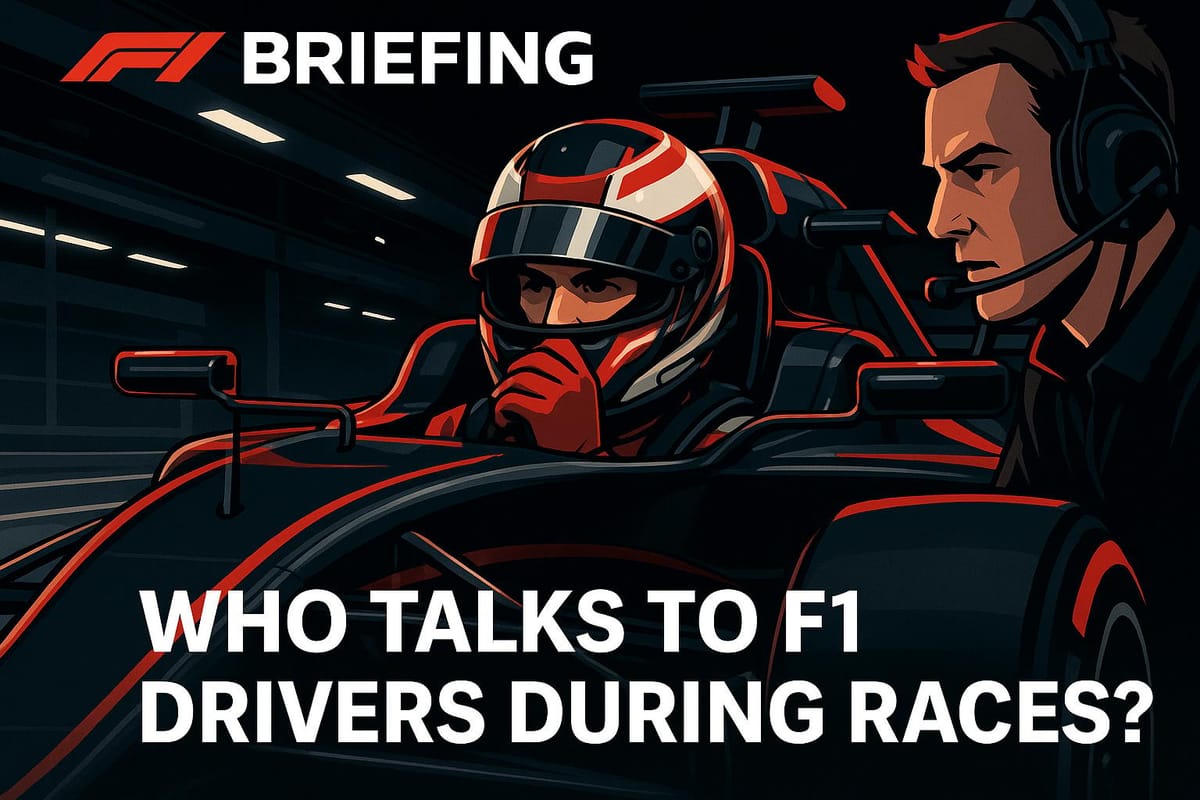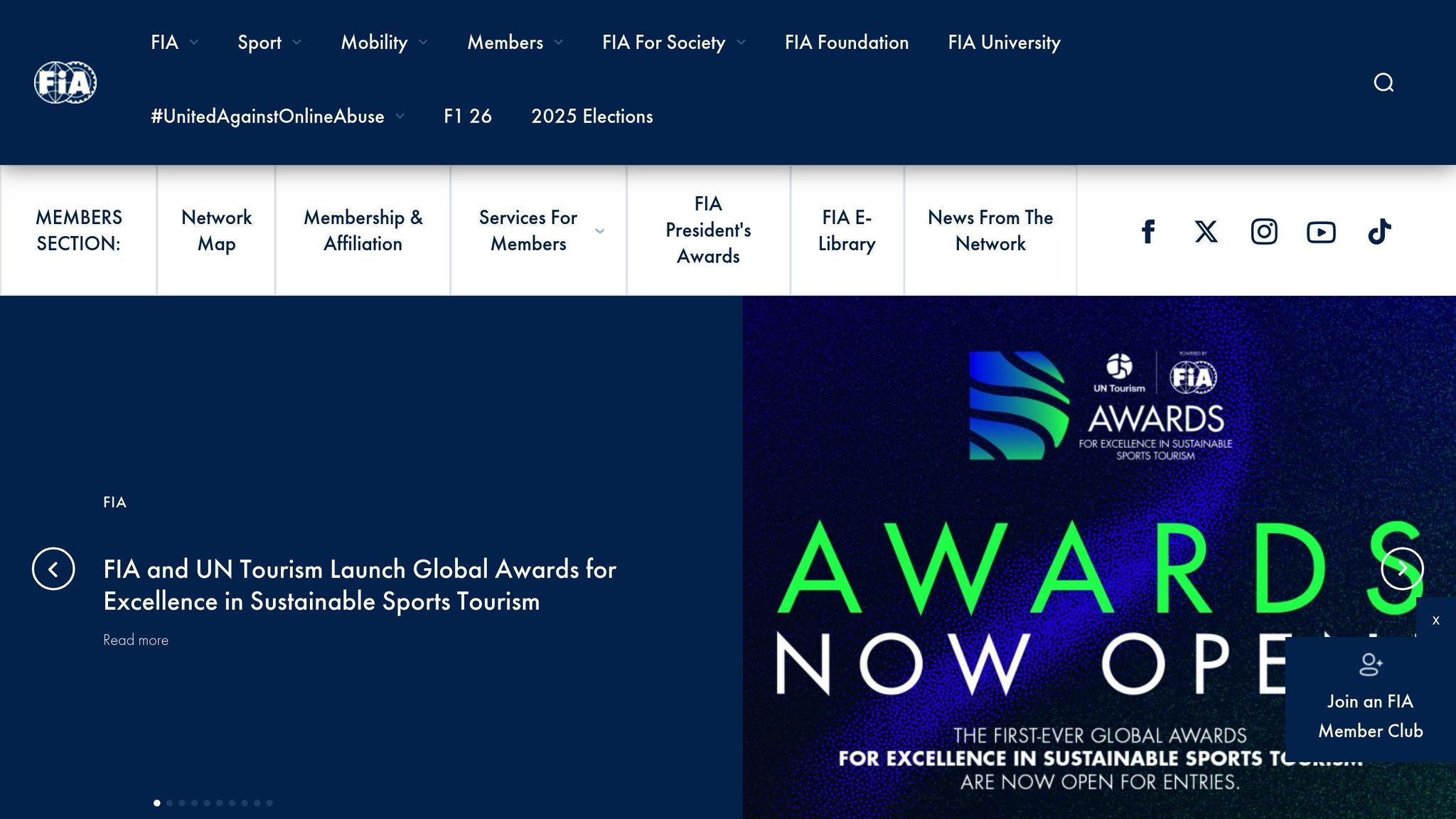Who Talks to F1 Drivers During Races?
Explore the vital communication roles in F1 racing, including race engineers, team principals, and strategy teams, and how they impact race outcomes.

In Formula 1, communication between drivers and their teams is essential for race success. Drivers rely on specific team members to provide real-time updates, manage strategy, and ensure safety. Here's the breakdown of who talks to drivers during races:
- Race Engineer: The primary point of contact. They provide updates on performance, strategy, and car health while filtering input from the team.
- Team Principal: Rarely speaks but steps in during critical moments, such as major strategy changes or team orders.
- Strategy Team: Offers data-driven advice, usually relayed through the race engineer, but may communicate directly for complex decisions.
Teams use advanced radio systems integrated into helmets, featuring noise-canceling microphones and encrypted transmissions to ensure clear and secure communication. The FIA regulates what teams can say, focusing on safety updates while limiting detailed strategic coaching to preserve driver autonomy.
Effective communication ensures drivers stay informed without being overwhelmed, enabling split-second decisions that can determine race outcomes.
How F1 Teams Talk to Drivers on Track 📻
The Race Engineer's Role
The race engineer acts as the driver’s main point of contact with the team, bridging the gap between the cockpit and the crew. They sift through mountains of data and turn it into clear, actionable advice, often in the heat of the moment.
What Race Engineers Do
During a Grand Prix, race engineers juggle multiple responsibilities, but their primary focus is delivering critical, split-second information to the driver. They constantly monitor performance metrics like lap times, tire temperatures, and other key data to keep the driver informed and competitive.
For example, they’ll update drivers on gaps and relative pace with messages such as, “Six seconds down but gaining”.
Engineers also advise on pit strategies, fuel usage, tire management, and any urgent car health issues. If sensors detect a problem - like suspension vibrations or uneven tire wear - engineers issue immediate warnings. A typical message might be:
"We're picking up safety-critical vibrations. Box now, please"
A real-world example of this came during the 2022 Melbourne Grand Prix, when George Russell was told:
"We'll need to cool the car down"
Following this guidance helped Russell manage engine overheating and secure a podium finish.
Race engineers also provide tactical updates, such as when to activate DRS (Drag Reduction System) if within one second of the car ahead, alerts about traffic or hazards on the track, and advice on adjusting Power Unit settings for better performance or reliability. In extreme cases, they may even call for the car’s retirement if the data shows a critical failure is imminent.
This constant flow of real-time information builds a foundation of trust between the driver and their engineer - a relationship that’s crucial when every second counts.
Why Drivers Depend on Race Engineers
Drivers lean heavily on their race engineers because they supply the precise, timely guidance needed to make split-second decisions. Over time, this relationship becomes one of mutual trust, built through countless high-pressure situations. Engineers provide critical details like tire temperatures, fuel levels, and gaps to competitors, ensuring the driver always has a clear picture of the race.
This trust becomes especially vital in moments of urgency. For instance, if an engineer advises an immediate pit stop due to a safety concern, the driver has to act without hesitation. Through repeated practice sessions and races, this bond deepens, creating a seamless flow of information that ensures the driver gets exactly what they need, exactly when they need it.
Other Team Members Who Communicate with Drivers
In addition to race engineers, other experts step in to provide critical support during key moments. These interactions are usually reserved for high-pressure situations that demand specialized expertise or top-level decision-making. Their input complements the race engineer's role by adding strategic depth and ensuring the team operates as a cohesive unit.
Team Principal: Executive-Level Input
Team principals rarely address drivers during races, but when they do, it’s typically in moments of heightened importance. These interactions often occur during safety car periods, red flag situations, or when major strategic shifts are required. Their voice carries weight, signaling that the situation goes beyond routine race operations.
Drivers might hear from the team principal when championship standings are on the line, during contentious incidents needing immediate clarification, or when team orders must be delivered with authority. The presence of the team principal in these communications underscores that the message represents the collective stance of the team, not just an individual opinion. This clarity is especially crucial when drivers challenge strategic decisions mid-race.
Unlike race engineers who focus on immediate tactical and technical details, team principals bring a broader perspective. They consider long-term implications, sponsor commitments, and overall championship goals. Their messages are concise and decisive, offering direction when the usual updates from the pit wall won’t suffice. This executive-level input ensures the team remains aligned and focused under pressure.
Strategy Team: Data-Driven Adjustments
While team principals handle high-level decisions, the strategy team provides detailed, data-backed guidance. These specialists are responsible for shaping race strategy by analyzing real-time data from various sources. Although their insights are usually relayed through the race engineer, they may communicate directly with drivers when complex strategy changes require explanation or when split-second opportunities arise.
The strategy team closely monitors factors like tire wear, fuel usage, weather conditions, and competitor behavior to identify the best moments for strategic moves. If a situation demands a significant deviation from the pre-race plan, they might speak directly to the driver to ensure the new approach is fully understood. This supplements the race engineer’s updates with a more forward-looking perspective.
For example, in unpredictable weather conditions, the strategy team might outline tire options to the driver, explaining the risks and rewards of each choice. These discussions allow the driver to weigh in, ensuring the decision aligns with their confidence and instincts on the track.
Their expertise becomes especially valuable during unpredictable or evolving race scenarios where multiple strategies are viable. Direct communication helps drivers grasp the logic behind potentially unconventional decisions, fostering trust in the team’s approach. By sharing insights on competitor strategies, optimal timing, or risk assessments, the strategy team equips drivers with the context they need to adapt effectively to shifting race dynamics.
How F1 Radio Systems Work
In Formula 1, while team roles shape the strategy, the technology behind radio communication ensures those strategies are executed with precision. These advanced systems allow teams to maintain constant contact with drivers, even in the chaotic, high-speed environment of a race. The challenge? Delivering crystal-clear audio while cutting through the deafening noise of engines, wind, and track interference.
F1 Radio Equipment and Setup
At the heart of F1 communication are helmet-integrated systems specifically designed for the sport. Each driver’s helmet is equipped with custom-molded earpieces that provide superior sound clarity and block out external noise. These earpieces connect to speakers that ensure team messages are heard clearly - no small feat when competing against the roar of engines spinning at 15,000 RPM.
Microphones are another critical component. Teams use ultra-sensitive microphones placed near the driver’s mouth, equipped with noise-canceling technology. These microphones adjust their sensitivity automatically based on ambient noise, ensuring the driver’s voice comes through clearly, regardless of whether the car is idling in the pit lane or racing at full throttle.
The transmission system operates on frequencies assigned by the FIA. To keep communications secure, these frequencies are encrypted, protecting strategic discussions from being intercepted by rival teams. Teams also use multiple channels, separating driver communication from internal team coordination.
On the pit wall, engineers work from advanced control panels loaded with features like multiple audio channels, instant replays, and emergency overrides. This setup allows race engineers to monitor driver communications while coordinating with strategists, data analysts, and other team members. To guard against failures, every system is built with redundant backups. If the primary radio system falters, teams can switch to backup frequencies or alternative methods, ensuring communication continues during critical moments.
Managing Radio Traffic
During a race, teams deal with a constant flood of data, from telemetry streams to strategy updates. The key is filtering out unnecessary noise so only the most critical information reaches the driver. This is where race engineers play a vital role - they decide, often in seconds, what the driver needs to hear and what can wait.
To avoid chaos, teams rely on strict communication protocols. The race engineer is usually the only voice a driver hears, with other team members funneling their input through this central figure. This prevents confusion and ensures messages are clear and focused. In high-pressure moments, teams may enforce radio silence, where only emergency updates are allowed, giving drivers the mental space to concentrate fully on the race.
The timing of radio messages is equally important. Teams avoid distracting drivers during high-speed sections, overtakes, or complex corners. Instead, they deliver updates during straights or less demanding parts of the track, where drivers can process the information without losing focus.
When multiple updates compete for airtime, prioritization systems determine what gets through. Safety messages always come first, followed by urgent strategic updates like pit stop calls or position changes. Routine information, like lap times or competitor updates, is often condensed or delayed to avoid overwhelming the driver.
To keep communication efficient, teams use coded language and abbreviations. Instead of lengthy explanations, race engineers rely on pre-agreed phrases that drivers can instantly understand. This shorthand reduces radio traffic while ensuring drivers get the information they need to make split-second decisions in the ever-changing dynamics of a race.
FIA Rules for Radio Communication

The FIA has set specific rules for radio communication in Formula 1, aiming to strike a balance between safety and fair competition. These rules are designed to ensure that drivers rely on their own instincts and skills during races. While teams are allowed to share crucial safety updates, the regulations discourage excessive strategic guidance that could influence real-time decisions. Though the exact details of these restrictions aren’t publicly disclosed, the combination of these rules and advanced radio systems helps keep the racing competitive and secure.
What Teams Cannot Say to Drivers
The regulations emphasize that teams should avoid giving drivers detailed strategic instructions that could undermine their ability to make independent decisions. Teams are allowed to communicate essential safety information or basic operational updates, but they are generally restricted from offering extensive coaching or tactical advice. This approach ensures that the drivers remain the primary decision-makers on the track, preserving the competitive integrity of the sport.
Backup Communication Methods
When radio systems fail, teams have backup methods in place to deliver critical information to drivers. Tools like pit boards or visual signals are used as alternatives to radio communication. These approved backup protocols ensure that vital updates - especially those related to safety - can still reach the driver. By limiting communication to essential updates, the FIA reinforces the focus on driver skill and fair competition.
The FIA’s radio communication rules highlight the importance of maintaining a level playing field. Drivers receive the support they need to stay safe, but the ultimate racing decisions rest firmly in their hands.
Conclusion: How Communication Shapes F1 Race Results
In Formula 1, team communication is the bridge that turns a driver's skill into race-winning results. During the intense atmosphere of a Grand Prix, every voice on the team plays a critical role in shaping the outcome.
Race engineers are the lifeline, delivering real-time data and tactical advice to help drivers make split-second decisions. The strategy team and team principals add their expertise, stepping in during pivotal moments when championship points or major strategic shifts hang in the balance.
While the FIA enforces restrictions on certain types of strategic instructions to preserve a driver's autonomy, essential safety updates remain a priority. These rules strike a balance between maintaining fair competition and embracing the cutting-edge technology that defines modern Formula 1.
Behind the scenes, advanced radio systems ensure that every critical message is heard with clarity. This technology enables seamless coordination among team members, allowing them to operate as a unified force under immense pressure. It's this synergy that transforms raw talent into championship-winning performances.
FAQs
Who communicates with F1 drivers during a race, and how is information prioritized?
During a race, F1 drivers stay in constant touch with their race engineers through team radio. The engineers focus on delivering key updates that directly affect strategy and safety - things like tire wear, fuel status, track conditions, and telemetry readings.
Each driver has a unique communication preference. Some want regular updates to stay fully informed, while others prefer to hear only the essentials to maintain focus. Race engineers ensure their messages are clear and to the point, giving drivers the information they need to make quick, critical decisions without unnecessary distractions.
When does a team principal talk directly to an F1 driver during a race?
A team principal often takes on the role of direct communicator with an F1 driver during key moments in a race. This can involve giving strategic directions, guiding the driver through overtakes or defensive moves, or managing crucial elements like tire and fuel strategies.
They might also step in to motivate or steady the driver during high-pressure situations, or relay important updates about race conditions, competitor tactics, or unexpected developments. While this kind of direct communication isn’t common, it tends to happen during decisive moments when clear leadership is absolutely critical.
How do F1 teams ensure secure and reliable communication with drivers during races?
F1 teams depend on encrypted digital radio systems to keep their communication with drivers secure and efficient during races. These systems, managed by expert providers, use sophisticated encryption techniques to block any attempts at interception and safeguard sensitive information. Each team operates on designated frequencies, which are closely monitored by FIA officials to ensure compliance with the rules.
To promote fair play, there are strict guidelines on what teams can communicate to drivers. For example, coaching instructions are off-limits. This approach ensures that while communications are protected, the driver’s autonomy and expertise remain a crucial part of the competition.




